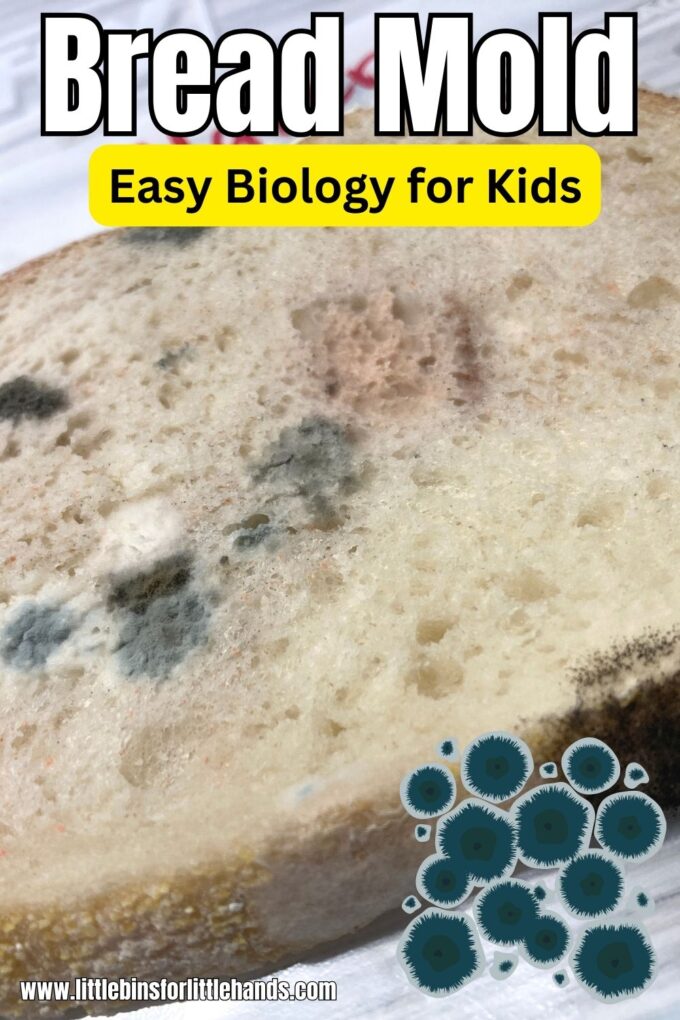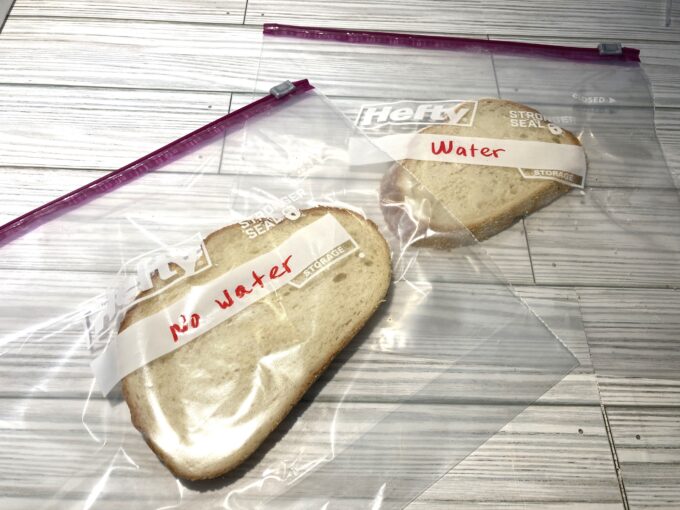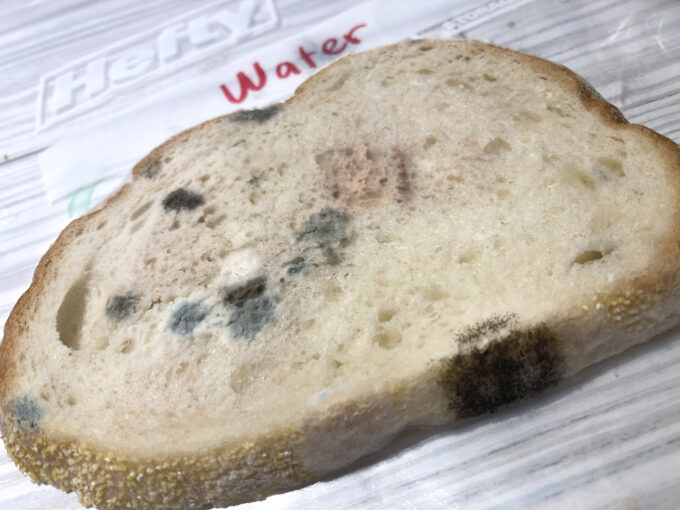Ever ended up with a loaf of moldy bread at home? It’s not something you want to eat! Instead grow mold on bread for science, and investigate how factors such as moisture, temperature, and air affect mold growth. A fun and easy way to observe the life cycle of mold for a hands-on biology experiment for kids.

Explore Mold With Bread
This bread mold experiment is a fun way to learn about microorganisms you cannot see. All you need are a few supplies you would have in your kitchen.
Our science experiments are designed with you, the parent or teacher, in mind! Easy to set up, and quick to do, most activities will take only 15 to 30 minutes to set up and are heaps of fun! Plus, our supplies lists usually contain only free or cheap materials you can source from home!
Grab some slices of bread and find out what happens when you add water! Get your kids to make a prediction or two; what do they think will happen to the bread?
Using The Scientific Method
The scientific method is a process or method of research. A problem is identified, information about the problem is gathered, a hypothesis or question is formulated from the information, and the hypothesis is tested with an experiment to prove or disprove its validity.
Sounds heavy… What in the world does that mean?!? It means you don’t need to try and solve the world’s biggest science questions! The scientific method is all about studying and learning things right around you.
As children develop practices that involve creating, gathering data evaluating, analyzing, and communicating, they can apply these critical thinking skills to any situation.
LEARN MORE HERE: Using The Scientific Method with Kids
Note: The use of the best Science and Engineering Practices is also relevant to the topic of using the scientific method. Read more here and see if it fits your science planning needs.
The Science of Mold
Explores the fascinating world of fungi, like Rhizopus stolonifer, that often grow on bread with simple bread mold experiment. These tiny organisms love damp places so bread, with its moisture, is like a paradise for them.
Mold spores, which are everywhere in the air, land on the bread. When it’s warm and there’s enough air and moisture then these spores start to grow into visible mold.
They grow quickly by using special substances that break down the bread’s sugars. The fuzzy stuff you see on moldy bread is made of tiny threads called hyphae, which join together to form a network called mycelium. This helps the mold take in food from the bread.
Understanding bread mold helps us to see how fungi grows and shows how important conditions
like warmth, air, and moisture are for these microorganisms to spread.
Turn It Into A Bread Mold Science Fair Project
Science projects are an excellent tool for older kiddos to show what they know about science! Plus, they can be used in all sorts of environments including classrooms, homeschool, and groups.
Kids can take everything they have learned about using the scientific method, stating a hypothesis, choosing variables, making observations and analyzing and presenting data.
Want to turn this experiment into an awesome science fair project? Check out these helpful resources.
Free Printable Science Journal Worksheets
Create a science notebook with these easy-to-use science worksheets to accompany any experiment. Grab your free science process journal pack!
Bread Mold Experiment Variations
Extend the learning by varying your experiment:
Remember to only change one variable for each experiment!
- Add the same amount of water to different types of bread.
- Place the same type of bread in light or dark conditions.
- Use the same type of bread and vary the amount of water on each.
- Place the same type of bread in a warm area and one in a cold area. Use a thermometer to work out the temperature.
- Place the same type of bread in a bag and one directly exposed to air.
Bread Mold Experiment
Why not use extra slices of bread and set up this germ science experiment!
Supplies:
- 2 slices of bread
- 2 zip bags
- Marker
- Water
Instructions:
STEP 1: Label the plastic bags to identify each slice.
TIP: Don’t forget to make one or two predictions before you start. What do you think will happen to each slice?
STEP 2: Add 10 drops of water to one slice and seal.

STEP 3: Now add a dry piece of bread to the second bag.

STEP 4: Place the slices in a warm, dark place if possible. Observe and record.
Tip: Make observations every 2nd day over the course of 2 weeks depending on how fast the mold is growing.

Which piece of bread had the most mold on it? Make sure to read the science of mold to find out why.

More Fun Science Experiments To Try
- Investigate seed germination with a seed jar.
- Set up a mini-greenhouse.
- Make a model of your heart or of your lungs.
- Learn with animal cell and plant cell coloring sheets.
- Try this easy strawberry DNA lab.
- Set up a germ experiment.
Helpful Science Resources
Here are a few resources that will help you introduce science more effectively to your kiddos or students. Then you can feel confident yourself when presenting materials. You’ll find helpful free printables throughout.
- Best Science Practices (as it relates to the scientific method)
- Science Vocabulary
- 8 Science Books for Kids
- All About Scientists
- Science Supplies List
- Science Tools for Kids
- Join us in the Club
Printable Science Projects For Kids
If you’re looking to grab all of our printable science projects in one convenient place plus exclusive worksheets and bonuses like a STEAM Project pack, our Science Project Pack is what you need! Over 300+ Pages!
- 90+ classic science activities with journal pages, supply lists, set up and process, and science information. NEW! Activity-specific observation pages!
- Best science practices posters and our original science method process folders for extra alternatives!
- Be a Collector activities pack introduces kids to the world of making collections through the eyes of a scientist. What will they collect first?
- Know the Words Science vocabulary pack includes flashcards, crosswords, and word searches that illuminate keywords in the experiments!
- My science journal writing prompts explore what it means to be a scientist!!
- Bonus STEAM Project Pack: Art meets science with doable projects!
- Bonus Quick Grab Packs for Biology, Earth Science, Chemistry, and Physics









